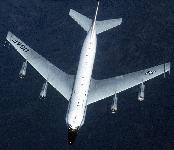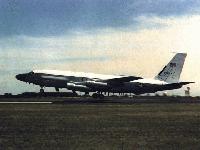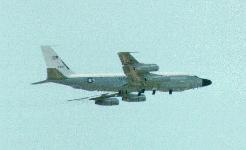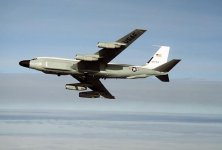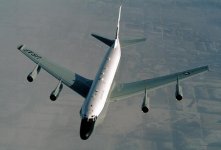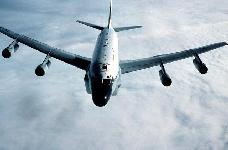|
|
|
Basic
roles include:
The RIVET JOINT aircraft operated by the 55th Wing, Offutt Air Force Base, Neb., provide direct, near real-time reconnaissance information and electronic warfare support to theater commanders and combat forces. In support of the 55th, the 95th Reconnaissance Squadron operates out of Mildenhall and provides pilots and navigators to fly the aircraft. The 488th Intelligence Squadron provides the intelligence personnel who work in the back of the plane. Since the beginning of Operation Joint Endeavor December 21, 1995 through May 1996 the 95th and 488th flew 625 hours and 72 sorties together in support of the peacekeeping operation in Bosnia-Herzegovina.
RIVET JOINT (RC-135V/W) is an air refuelable theater asset with a nationally tasked priority. It collects, analyzes, reports, and exploits enemy BM/C4I. During most contingencies, it deploys to the theater of operations with the airborne elements of TACS (AWACS, ABCCC, Joint STARS, etc.) and is connected to the aircraft via datalinks and voice as required. The aircraft has secure UHF, VHF, HF, and SATCOM communications. Refined intelligence data can be transferred from Rivet Joint to AWACS through the Tactical Digital Information Link TADIL/A or into intelligence channels via satellite and the TACTICAL INFORMATION BROADCAST SERVICE (TIBS), which is a nearly real-time theater information broadcast.
On February 12, 1997 Sanders, a Lockheed Martin Company, was selected by the Joint Airborne Signals Intelligence (SIGINT) Program Office for development and demonstration of the Joint SIGINT Avionics Family (JSAF) Low Band Subsystem (LBSS). Major subcontractors include: Radix Technologies, Inc. of Mountain View, Calif.; Applied Signal Technologies (APSG) of Sunnyvale, Calif.; and TRW System Integration Group, also of Sunnyvale. Radix will provide radio frequency (RF) and digital signal processing subsystems; APSG will develop special signal processing subsystems; and TRW will be responsible for high speed networking and computing subsystems. The JSAF low band subsystem is a platform-independent, modular, reconfigurable suite of hardware and software that can address multiple mission scenarios aboard a variety of aircraft. It will significantly enhance the ability of reconnaissance platforms to detect and locate modern enemy communications systems and provide real time intelligence on enemy intentions and capabilities to the warfighter. Initially, JSAF LBSS will be deployed on U.S. Air Force RC-135 Rivet Joint aircraft and other special Air Force platforms as well as the U.S. Army's RC-7 (Airborne Reconnaissance Low) and the U.S. Navy's EP-3 aircraft. JSAF LBSS will also be capable of deployment on unmanned air vehicles (UAVs) in the future. JSAF collection systems intercept, exploit, and report on modern modulation and low probability of detection communications and radar signals. It permits the collection of signals in the presence of co-channel interfering signals, and provides interoperability between primary DOD airborne collection platforms, establishing the infrastructure to support near-real-time exchange of information for rapid signal geolocation and targeting. Provide compliance with DOD directed Joint Airborne SIGINT Architecture (JASA). Current aircraft architecture and collection system have insufficient capability to intercept modern modulation and low probability of detection communications and radar signals. System requires improvements to accurately measure signal polarization and angle of arrival to the required accuracy, and to process signals in the presence of co-channel interfering signals. DOD airborne collection platforms do not operate under a common architecture and are limited in their ability to exchange data among platforms for the purpose of rapid signal triangulation for geolocation and targeting. Four aircraft undergo PDM per year. Current funding in FY01/02 only supports JSAF modification for three of the four aircraft during those years. Result will be 2 different aircraft configurations moving thorugh PDM. The impact includes dual qualified aircrews, split logistics, increased training, increased cost for "out-of-cycle" modification.
The RIVET JOINT Joint Airborne SIGINT Architecture (JASA) High Band Sub-System (HBSS) Upgrade procures and installs upgrades to the RIVET JOINT’s high band antennas, RF distribution network, and software to intercept, exploit, and report on modern modulation and low probability of detection communications and radar signals. It permits the collection of signals in the presence of co-channel interfering signals, and provides interoperability between primary DOD airborne collection platforms, establishing the infrastructure to support near-real-time exchange of information for rapid signal geolocation and targeting. Provide compliance with DOD directed Joint Airborne SIGINT Architecture (JASA). The JSAF CRD (CAF 002-88 Joint CAF -USA, USN, USMC CAPSTONE Requirements Document for JOINT SIGINT AVIONICS FAMILY) requires all airborne reconnaissance aircraft to migrate to JASA compliance by 2010. Current aircraft architecture and collection system have insufficient capability to intercept modern modulation and low probability of detection communications and radar signals. System requires improvements to accurately measure signal polarization and angle of arrival to the required accuracy, and to process signals in the presence of co-channel interfering signals. DOD airborne collection platforms do not operate under a common architecture and are limited in their ability to exchange data among platforms for the purpose of rapid signal triangulation for geolocation and targeting.
The RIVET
JOINT SHF High Gain Steerable Beam Antenna Upgrade I will procure and install
a new antenna array in the cheek to provide increased sensitivity and signal
separation for selected frequency bands. It provides an increased number
of steerable beams in bands that currently have steerable beams, and provides
steerable beams in bands not currently steerable beam capable. Increases
the number of signals that can be processed simultaneously and increases
signal selectivity against co-channel signals. Increasing number of low
power signals and increased signal density have decreased the ability to
collect tasked targets due to co-channel signal interference. Antenna improvements
permit deeper target penetration against low power emitters or increased
standoff ranges. The current SHF antenna array does not provide the sensitivity
or selectivity required to collect low power or co-channel signals, reducing
probability of intercept.
RIVET JOINT
SHF High Gain Steerable Beam Antenna Upgrade II procures and installs a
new antenna array in the cheek to provide increased sensitivity and signal
separation in selected frequency bands. Provides an increased number of
steerable beams in bands that currently have steerable beams, and provides
steerable beams in bands not currently steerable beam capable. Increases
the number of signals that can be processed simultaneously and increases
signal selectivity against co-channel signals. Increasing number of low
power signals and increased signal density have decreased the ability to
collect tasked targets. Antenna improvements permit deeper target penetration
against low power emitters or increased standoff ranges. The current SHF
antenna array does not provide the sensitivity or selectivity required
to collect low power or co-channel signals, reducing probability of intercept.
The RIVET JOINT High Frequency (HF) Direction Finding (DF) System procures and installs a ten element HF array antenna on RIVET JOINT to provide HF DF capability. Upgrades the Joint SIGINT Avionics Family (JSAF) LowBand SubSystem (LBSS) receiver to process HF DF. The current RIVET JOINT HF capability is limited to a long wire antenna. This configuration supports signal reception, but not HF DF. The aircraft is tasked to perform search, classification, collection, and DF of all militarily significant signals. This tasking includes signals in the HF band. Without HF DF, the aircraft will continue to have no DF capability in this increasingly significant frequency band. A ten element HF antenna array, and receiver upgrades are needed to perform HF DF operations. Without the installation of a ten element HF antenna array, RIVET JOINT will not be able satisfy the requirement to DF signals in the HF band.
The RIVET JOINT 360º Search, Acquisition, and Direction Finding System procures and installs a circular antenna array and receiver system designed to search, acquire and DF emitters over the full. The antenna will be centerline mounted on the aircraft underside. The antenna output will be routed to a new receiver dedicated to 360º intercept. The receiver output would be routed to existing processors for exploitation. The proposed implimentation will retain the high sensitivity and geolocation accuracy of the current system while adding an additional antenna array and receiver specifically for 360º coverage. RIVET JOINT is currently unable to satisfy the long-standing requirement to search, acquire, and DF emitters through the full 360º. The current radar acquisition and DF systems have a limited field of view, restricted to 120º on each side of the aircraft. Additionally, the operator can only select one side or the other. The aircraft is often employed in orbits requiring a greater antenna field of view, often from both sides of the aircraft, or from the nose and tail. The crew currently accomplishes this tasking by alternating antenna selection from side to side, and by changing aircraft headings. These tactics provide sequential, not simultaneous looks at the target area, and pose a significant probability of missing short-up-time and low-probability-of-intercept emitters.
RIVET JOINT
Wideband Line-of-Sight Data Link procures, installs and integrates a wideband
datalink terminal on the aircraft. Datalink would be line-of-sight capable.
Datalink will be interoperable with ground-tethered assets for data exchange
and exploitation. Permits airborne exploitation of UAV sensors. Provides
capability for cooperative direction finding for near instantaneous target
geolocation. Allows aircrews to draw on in-theater intelligence center
databases and processing capability. Provides for near-real-time interaction
between theater assets, increasing probability of intercepting targets,
and increasing geolocation accuracy of target locations. Airborne reconnaissance
platforms require a wideband datalink for interaction among platforms in
order to provide high probability of signal detection, provide accurate
and timely target geolocation, draw on theater atabases and processing
capability to exploit robust signals, and permit airborne access to UAV
sensor data. Without this upgrade, RIVET JOINT aircraft will not be able
to exchange data among in-theater reconnaissance platforms and draw on
CONUS based national assets to exchange data, cooperatively geolocate targets,
and exploit robust targets in near-real-time.
RIVET JOINT
Wideband SATCOM Data Link/Global Broadcast Service (GBS) procures, installs
and integrates a wideband datalink terminal on the aircraft. Datalink would
expand the capability of a wideband line-of-sight datalink to add SATCOM
capable. Datalink will be interoperable with ground-tethered assets for
data exchange and exploitation. Permits airborne exploitation of UAV sensors.
Provides capability for cooperative direction finding for near instantaneous
target geolocation. Allows aircrews to draw on in-theater intelligence
center databases and processing capability, or provide for reach-back to
CONUS intelligence center databases and processing capability. Provides
for near-real-time interaction between theater and national assets, increasing
probability of intercepting targets, and increasing geolocation accuracy
of target locations. Terminal will permit receipt of Global Broadcast Service.
Airborne reconnaissance platforms require a wideband datalink for interaction
among platforms in order to provide high probability of signal detection,
provide accurate and timely target geolocation, draw on theater and CONUS
databases and processing capability to exploit robust signals, and permit
airborne access to UAV sensor data. RIVET JOINT aircraft will not be able
to exchange data among in-theater reconnaissance platforms and draw on
CONUS based national assets to exchange data, cooperatively geolocate targets,
and exploit robust targets in near-real-time.
RIVET JOINT
Operator Workstation Upgrade procures and installs high resolution operator
displays to improve target detection and signal recognition. Wide band
fiber optic base audio distribution network to all operators. Wide band,
high capacity COTS audio recorders. High capacity, digital, reprogramable,
wideband demodulators and processors. Current display resolution is insufficient
to allow accurate signal detection and recognition of modern modulation
target signals. Several current target emitters exceed the bandwith of
the current audio distribution system, resulting in unintelligible audio
output. Several receiver outputs are routed to specific operator positions,
limiting flexibility in responding to theater driven dynamic target environments.
Bandwidth and capacity of current recorders is exceeded by an emerging
class of wideband modern modulation target emitters. Bandwidth and capacity
of current signal demodulators is exceeded by an emerging class of wideband
modern modulation target emitters. Current demodulators are not reprogramable.
It is expensive and time consuming to reconfigure them to process different
target emitters.
RIVET JOINT
Cockpit Modernization includes the RIVET JOINT in the Air Force PACER CRAG
initiative to upgrade the C-135 fleet cockpit, and installs the GATM/FANS
avionics required to operate in the evolving civil air structure. PACER
CRAG installs new compasses, radar, multi-function displays, and global
positioning system/flight management system. New fuel panel, Mode S IFF,
TCAS, precision altimeters, and DAMA compliant, 8.333 KHz channel radios
are included in this upgrade. The upgrade provides RIVET JOINT and RJ Trainer
(TC-135) aircraft commonality with the C-135 fleet for training, logistics,
and parts. Eliminated "vanishing vendor" problems associated with diverging
from the KC-135 avionics. Permits aircraft to comply with ICAO navigation
and communication standards to operate in the trans-oceanic and European
portions of the commercial air structure. Improves safety, reliability,
and maintainability of aircraft. Aircraft will be denied access to increasing
portions of civil air space without proper navigation/communications equipment.
Current avionics systems will become unsupportable as KC-135 migrates to
newer equipment. Commonality will be lost with the rest of the C-135 fleet.
Common parts supply base will not be available.
CFM-56 Re-engining
completes re-engining of RC-135 aircraft with CFM-56 engines, and modifies
the airframes to support re-engining. The project decreases cost of ownership
and increases operational capability by installing new, fuel efficient
engines. The upgrade also reduces maintenance manpower and logistics costs;
the new engine is more reliable than the current engine, and the engine
is common with the AMC KC-135 fleet. This project extends unrefueled range
and time-on-station, and permits operations at higher altitudes, increasing
airborne sensor field of view and effectiveness. Increased altitude range
provides flexibility to airspace planners integrating aircraft into conjested
airspace just behind the FEBA. The new engines decrease dependency on tankers
for air refueling, and provide a capability to takeoff on shorter runways
at increased gross weights. The project facilitates two-level maintenance
concept reducing costs by 32%, and supports improved aircraft environmental
system prolonging sensitive sensor life. Failure to fund re-engining to
completion will leave a logistically split RC-135 fleet, equipped with
two completely different engines. Increased cost of ownership due to duplicate
spares at each operating location. Current TF-33 engines will become more
difficult and costly to support requiring significant increases in future
O&M costs (TF-33 parts no longer in production). The RC-135 fleet would
lack commonality with re-engined KC-135 fleet, and the GAO validated $1.7B
life cycle savings (total RC-135 program) would not be realized if this
project was not funded.
RIVET JOINT
Air Conditioning (A/C) Environmental Cooling Modifications procures and
installs a vapor cycle cooling system. Includes a liquid cooling loop and
heat exchangers. The system will provide in excess of 10 tons of additional
cooling at all operating altitudes. Permits effective operation of collection
systems added to the aircraft over the last decade. Reduces the requirements
for auxiliary air conditioning during ground support operations. The heat
load of the "mission equipment" has exceeded the capacity of the standard
C-135 air-conditioning system. Skin heat exchangers have been installed
to effect additional cooling. This system is only effective at altitudes
in excess of 25,000 ft and has reached its capacity. To allow future growth
in system capabilities, flexibility in operations, and crew comfort, additional
capacity must be obtained. Without increased A/C capability, future growth
of aircraft mission equipment, operational flexibility, and crew comfort
will be curtailed.
The RIVET
JOINT Mission Trainer (RJMT) will provide a high fidelity ground trainer
for RC-135 RIVET JOINT reconnaissance compartment personnel, using aircraft
hardware and software. The trainer will be equipped with signal generators
to create and display a full range of radar and communications signals
to the reconnaissance crew. A complex, syncronized signal environment can
be presented to the crew, permitting coordinated exploitation of these
signal. The trainer will be equipped with Link-11, Link-16, and TIBS datalinks
to train aircrew to effectively interact with other battle management assets.
The trainer will be Distributed Interactive Simulation capable, permitting
RIVET JOINT participation in large scale exercises. The RJMT will provide
initial qualification, currency, and upgrade training. RJMT is required
to conduct efficient and cost effective initial qualification, continuation/proficiency,
and specific mission area training for RC-135 reconnaissance compartment
aircrew. Current RC-135 mission training devices are limited to position
mock-ups, outdated part-task trainers, PC-based procedural trainers, and
audio playback workstations. These devices are supplimented with extensive
airborne training flights on mission aircraft. The heavy dependence upon
mission aircraft directly impacts training timeliness, continuity, and
costs, and this training does not adequately simulate a challenging collection
environment. RJMT will relieve the training load in the ops squadron, reduce
dependence on aircraft availability for training, and facilitate decreasing
the total aircrew TDY rate to 120 days per year (ACC goal). RJMT will provide
an improved margin of safety during contingency operations. The only contingency
training available is OJT during actual operations. The simulator will
provide a safe controlled environment to practice tactics, develop new
procedures, and exploit new capabilities. RJMT will allow RC-135 aircrews
to interact, through Distributed Interactive Simulation (DIS), with other
platforms’ simulators. Through electronic exercises, the RJMT will provide
aircrew exposure to multiple interoperability issues, tactics, and procedures.
RC-135 operational effectiveness is significantly impacted because an integrated
training device is not available for the training of crewmembers in Sensitive
Reconnaissance Operations (SRO), contingency support, SIOP missions, and
exercises. Ops tempo is reduced to support initial training and proficiency
requirements. Air crewmember TDY will continue to exceed the stated ACC
goal of 120 days per year. Capability to train entire squadrons on aircraft
equipment modifications/upgrades is not available. Capability for RC-135
aircrews to electronically exercise with other platform simulators developing
new tactics and procedures, performing interoperability issues will not
be available.
RIVET JOINT
Crew Comfort Upgrade installs a modern, commercial aircraft-class latrine
for crew comfort. New latrine will provide increased holding capacity and
the capability to be serviced, from the ground, using current field servicing
equipment. Provides a sink, with fresh running water, allowing aircrews
to wash their hands. Current aircraft latrine leaks and lacks privacy requirements
needed for combined male/female aircrews. Waste leakage is causing corrosion
problems with aircraft structural components. The smell of the waste/disinfectant
fouls the cabin air. Increased aircrew stress due to inferior latrine facility
which produces waste/disinfectant odors inside the mission crew area. Leakage
corrodes the aircraft structural components.
| AC # | Name | Ordered | Delivered | Notes | |
| 62-4125 | 1996 | 1998 | RC-135W [ex C-135B] | ||
| 62-4127 | 1996 | 1998 | RC-135W [ex C-135B] | ||
| 62-4129 | Greyhound | Feb 87 | 22 Apr 88 | TC-135W trainer [ex C-135B] | |
| 62-4130 | 1996 | 1998 | RC-135W [ex C-135B] | ||
| 10 | 62-4131 | Junk Yard Dog | Jun 79 | 09 Mar 81 | RC-135W [ex RC-135M] |
| 13 | 62-4132 | Anticipation | 30 Nov 84 | RC-135W [ex RC-135M] | |
| 12 | 62-4134 | The Flying W | 07 Jan 81 | 16 Aug 81 | RC-135W [ex RC-135M] |
| 9 | 62-4135 | Rapture | 05 Sep 78 | 15 Nov 80 | RC-135W [ex RC-135M] |
| 11 | 62-4138 | Jungle Assassin | 09 Jan 80 | Jul 81 | RC-135W [ex RC-135M] |
| 14 | 62-4139 | Sniper | 22 Jan 85 | RC-135W [ex RC-135M] | |
| 8 | 63-9792 | 17 Oct 75 | 04 Aug 77 | RC-135W [ex RC-135U] | |
| 7 | 64-14841 | Red Eye | 01 Jan 75 | 19 Jan 78 | RC-135V [ex RC-135C] |
| 2 | 64-14842 | Fair Warning | 20 Nov 73 | 05 Jan 75 | RC-135V [ex RC-135C] |
| 3 | 64-14843 | Don't Bet on It | 04 Dec 73 | 05 Feb 75 | RC-135V [ex RC-135C] |
| 4 | 64-14844 | Problem Child | 08 Jan 74 | 03 Mar 75 | RC-135V [ex RC-135C] |
| 5 | 64-14845 | Luna Landa | 01 Oct 74 | 21 Nov 75 | RC-135V [ex RC-135C] |
| 6 | 64-14846 | 22 Jan 74 | 18 Dec 75 | RC-135V [ex RC-135C] | |
| 1 | 64-14848 | 01 Dec 72 | 08 Aug 73 | RC-135V [ex RC-135C] | |
| 15 | 14 Oct 99 | RC-135W [ex C-135B] |
| Primary Function: | Signals Intelligence Collection |
| Contractor: | RC-135V
- LTV
RC-135W - E-Systems |
| Power Plant: | Four JT3D engines |
| Length: | 152'11" (46.6 m); |
| Height: | 42'6" (12.9 m); |
| Weight: | 171,000
pounds (77,565 Kg)-- Empty
155,000 pounds (70,307 Kg)-- Max Fuel 336,000 pounds (152,408 Kg)-- Max Gross |
| Wingspan: | 145'9" (44.4 m); |
| Speed: | .84 Mach |
| Range: | 11 hours -- 20 hours with air refueling |
| Unit Cost: | |
| Crew: | Flight crew of 4 plus mission crew (mission crew size varies according to mission) |
| Date Deployed: | 1996 |
| Inventory: | Active force, 14 (3 more to be delivered by 1998); ANG, 0; Reserve, 0 |
